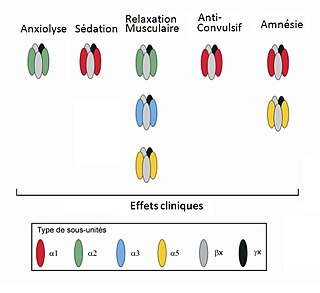
The GABA receptors are a class of receptors that respond to the neurotransmitter gamma-aminobutyric acid (GABA), the chief inhibitory compound in the mature vertebrate central nervous system. There are two classes of GABA receptors: GABAA and GABAB. GABAA receptors are ligand-gated ion channels ; whereas GABAB receptors are G protein-coupled receptors, also called metabotropic receptors.
The GABAA-rho receptor is a subclass of GABAA receptors composed entirely of rho (ρ) subunits. GABAA receptors including those of the ρ-subclass are ligand-gated ion channels responsible for mediating the effects of gamma-amino butyric acid (GABA), the major inhibitory neurotransmitter in the brain. The GABAA-ρ receptor, like other GABAA receptors, is expressed in many areas of the brain, but in contrast to other GABAA receptors, the GABAA-ρ receptor has especially high expression in the retina.
Beta waves, or beta rhythm, are a neural oscillation (brainwave) in the brain with a frequency range of between 12.5 and 30 Hz. Beta waves can be split into three sections: Low Beta Waves ; Beta Waves ; and High Beta Waves. Beta states are the states associated with normal waking consciousness.

Gamma-aminobutyric acid receptor subunit gamma-2 is a protein that in humans is encoded by the GABRG2 gene.

Gamma-aminobutyric acid receptor subunit alpha-1 is a protein that in humans is encoded by the GABRA1 gene.

The GABAA beta-2 subunit is a protein that in humans is encoded by the GABRB2 gene. It combines with other subunits to form the ionotropic GABAA receptors. GABA system is the major inhibitory system in the brain, and its dominant GABAA receptor subtype is composed of α1, β2, and γ2 subunits with the stoichiometry of 2:2:1, which accounts for 43% of all GABAA receptors. Alternative splicing of the GABRB2 gene leads at least to four isoforms, viz. β2-long (β2L) and β2-short. Alternatively spliced variants displayed similar but non-identical electrophysiological properties. GABRB2 is subjected to positive selection and known to be both an alternative splicing and a recombination hotspot; it is regulated via epigenetic regulation including imprinting and gene and promoter methylation GABRB2 has been associated with a number of neuropsychiatric disorders, and found to display altered expression in cancer.

Gamma-aminobutyric acid receptor subunit beta-1 is a protein that in humans is encoded by the GABRB1 gene.

Gamma-aminobutyric acid receptor subunit alpha-6 is a protein that in humans is encoded by the GABRA6 gene.

Gamma-aminobutyric acid receptor subunit alpha-3 is a protein that in humans is encoded by the GABRA3 gene.

Gamma-aminobutyric acid receptor subunit alpha-2 is a protein in humans that is encoded by the GABRA2 gene.

Gamma-aminobutyric acid (GABA) A receptor, alpha 5, also known as GABRA5, is a protein which in humans is encoded by the GABRA5 gene.

Gamma-aminobutyric acid receptor subunit epsilon is a protein that in humans is encoded by the GABRE gene.

Gamma-aminobutyric acid receptor subunit alpha-4 is a protein that in humans is encoded by the GABRA4 gene.

Gamma-aminobutyric acid receptor subunit rho-2 is a protein that in humans is encoded by the GABRR2 gene.

GABAA receptor-γ3, also known as GABRG3, is a protein which in humans is encoded by the GABRG3 gene.

Gamma-aminobutyric acid receptor subunit delta is a protein that in humans is encoded by the GABRD gene. In the mammalian brain, the delta (δ) subunit forms specific GABAA receptor subtypes by co-assembly leading to δ subunit containing GABAA receptors.

Gamma-aminobutyric acid receptor subunit pi is a protein that in humans is encoded by the GABRP gene.

Gamma-aminobutyric acid receptor subunit gamma-1 is a protein that in humans is encoded by the GABRG1 gene. The protein encoded by this gene is a subunit of the GABAA receptor.
Dup15q syndrome is the common name for chromosome 15q11.2-q13.1 duplication syndrome. This is a neurodevelopmental disorder, caused by the partial duplication of Chromosome 15, that confers a strong risk for autism spectrum disorder, epilepsy, and intellectual disability. It is the most common genetic cause of autism, accounting for approximately 1-3% of cases. Dup15q syndrome includes both interstitial duplications and isodicentric duplications of 15q11.2-13.1.












